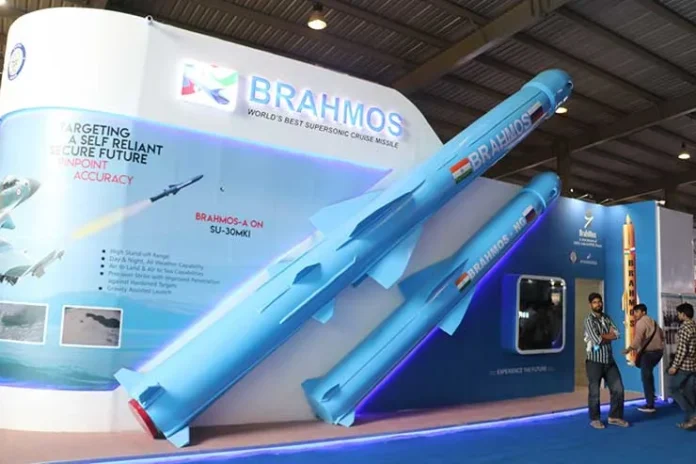New Delhi: In a significant development for regional defence cooperation and India’s strategic outreach, Malaysia and Vietnam have expressed strong interest in acquiring or integrating India’s BRAHMOS-A air-launched cruise missile on their Su-30MKM fighter jets, media reports said.
This represents a landmark shift in India’s defence export trajectory, potentially making both countries the first foreign operators of the BRAHMOS in its advanced air-launched configuration. The prospective deals underscore not only the growing trust in India’s defence capabilities but also the increasing role of Indian defence technology in shaping the evolving security architecture of Southeast Asia.
The BRAHMOS missile, named after the Brahmaputra and Moskva rivers, is a product of Indo-Russian collaboration between India’s Defence Research and Development Organisation (DRDO) and Russia’s NPO Mashinostroyenia.
It remains the fastest operational cruise missiles in the world, capable of striking targets at speeds ranging from Mach 2.8 to Mach 3. With the induction of the air-launched BRAHMOS-A variant, India has already achieved successful integration with its Su-30MKI fleet — a development that demanded rigorous structural reinforcements of the aircraft.
Among these modifications were the strengthening of fuselage sections, hard-points, and mounting systems to withstand the stresses imposed by the 2.5-ton missile during launch. This technical experience positions Hindustan Aeronautics Limited (HAL) as an indispensable partner for Malaysia and Vietnam in their envisioned missile integration process.
Vietnam is reportedly considering the acquisition of 36 Su-30MKM fighters to be jointly equipped with BRAHMOS-A, while Malaysia has shown firm intent to integrate the missile into its current fleet of 18 Su-30MKMs. Both countries operate variants of the Su-30 platform closely related to India’s Su-30MKI, which simplifies technical compatibility.
However, as seen in India’s case, the adaptation is not straightforward and requires meticulous engineering, flight testing, and certification work. HAL is expected to play a guiding role in ensuring these aircraft are structurally fortified for successful missile carriage and deployment.
From an operational perspective, access to the BRAHMOS missile fundamentally alters the strike profiles of Southeast Asian air forces. With extended ranges of 450–800 km—far beyond its initial cap of 290 km—the BRAHMOS-A offers Vietnam and Malaysia the capacity to target high-value assets such as warships, airbases, command centres, and logistics hubs with precision, all from safe stand-off distances.
Such a capability significantly enhances deterrence, strengthens survivability, and grants both nations the ability to project power across regional flashpoints, including the South China Sea. In a theatre where air superiority and long-range precision strikes may prove decisive, the deployment of BRAHMOS can tip the balance in favour of states seeking to safeguard sovereignty and maritime security.
The geopolitical ramifications of this move are profound. Vietnam has long been locked in territorial disputes with China in the South China Sea, while Malaysia similarly faces pressure in protecting its Exclusive Economic Zone (EEZ).
Arming their Su-30s with BRAHMOS provides these nations with a credible deterrent against encroachment, bolstering not only their individual defence capabilities but also their collective strategic leverage. For India, this step marks a breakthrough in defence diplomacy: transitioning from a major arms importer to a credible net exporter of cutting-edge systems.
It strengthens defence partnerships with ASEAN nations, pushes the ‘Make in India’ initiative onto a global stage, and positions India as a trusted partner in the Indo-Pacific security framework.
However, several challenges remain before the full materialisation of these plans. Technically, the integration will involve significant costs, aircraft downtime, and extensive testing to certify safe operation. Financial negotiations, transfer-of-technology agreements, and maintenance logistics will need careful calibration.
Furthermore, geopolitical sensitivities—especially the anticipated response from Beijing—may require Malaysia and Vietnam to balance their acquisitions against broader diplomatic considerations. Nonetheless, both countries’ evident pursuit of BRAHMOS reflects their resolve to prioritise credible military deterrence in an increasingly contested regional environment.
The interest in BRAHMOS integration also coincides with India’s developmental push for BRAHMOS-II, a hypersonic successor that promises greater range and speed. The ongoing negotiations could, therefore, represent merely the first step in a deeper defence-industrial collaboration, with Southeast Asia potentially serving as a key export market for India’s next-generation weapon systems.
In conclusion, Malaysia’s and Vietnam’s overtures towards BRAHMOS-A integration onto their Su-30MKM fleets illustrate a convergence of operational necessity, geopolitical strategy, and India’s emerging role as a defence exporter.
Should these projects come to fruition, they will mark a historic moment—introducing BRAHMOS into foreign fighter fleets for the first time, enhancing the deterrence and strike potential of Southeast Asian powers, and solidifying India’s presence as a vital defence partner in the wider Indo-Pacific.
For Malaysia and Vietnam, this partnership represents more than just acquiring cutting-edge firepower—it provides a technological edge that could prove decisive in a region where military capability increasingly determines strategic outcomes.






